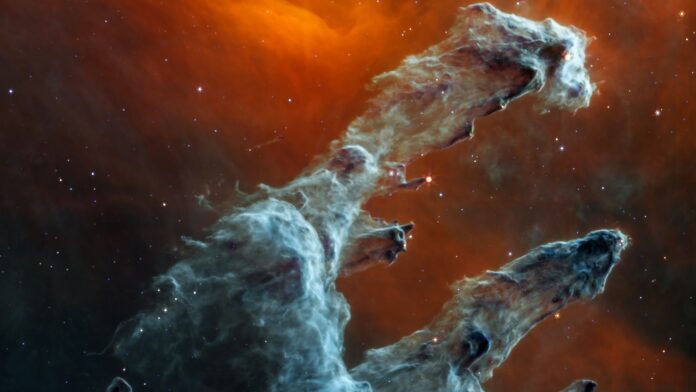Many have seen NASA’s iconic image of the “Pillars of Creation(Opens in a new window),” a giant dust cloud light years away that’s giving birth to new stars. But not like this.
On Friday, NASA released a new image of the Pillars of Creation, this time taken with the James Webb Space Telescope. And the resulting image is kind of spooky.
The photo(Opens in a new window) shows the Pillars of Creation —which reside in the Eagle Nebula— rising up like a ghostly hand. The gold and brown hues found in the original image, taken by the Hubble Space Telescope back in 1995, have been replaced with icy cold blues that look like they belong inside a haunted crypt.
NASA: ” Thousands of stars that exist in this region seem to disappear, since stars typically do not emit much mid-infrared light, and seemingly endless layers of gas and dust become the centerpiece”
(NASA)
The reason the image looks so different is because the James Webb telescope used its mid-infrared sensors to record the photo. These mid-infrared sensors can capture light human eyes can’t see, and are particularly adept at observing cosmic gas in detail. In contrast, Hubble’s original Pillars of Creation photo was snapped(Opens in a new window) over visible light, or the segment of light our eyes can see.
The original photo from the Hubble Space Telescope on the left compared to the new image from the James Webb Space Telescope.
(NASA)
“Interstellar dust cloaks the scene,” NASA said(Opens in a new window) in the announcement. “And while mid-infrared light specializes in detailing where dust is, the stars aren’t bright enough at these wavelengths to appear. Instead, these looming, leaden-hued pillars of gas and dust gleam at their edges, hinting at the activity within.”
The few stars that do appear “are the crimson orbs toward the fringes of the pillars,” NASA added. These young stars still remain shrouded in dust, allowing the telescope’s mid-infrared sensors to detect them.
“The densest areas of dust are the darkest shades of gray,” the space agency added. “The red region toward the top, which forms an uncanny V, like an owl with outstretched wings, is where the dust is diffuse and cooler.”
Recommended by Our Editors
The Pillars of Creation, but taken with the James Webb telescope’s near-infrared sensor.
(NASA)
The James Webb telescope also snapped(Opens in a new window) an image of the Pillars of Creation using its near-infrared sensor, which offers an entirely different look to the dust clouds. The near-infrared camera is able to capture hundreds of young stars forming around the cosmic gas.
Although the Pillars of Creation may look like a hand, NASA says(Opens in a new window) the dust cloud extends about four to five light years in size, making it far larger than our entire solar system. Meanwhile, the entirety of the Eagle Nebula spans about 70 by 55 light-years. The nebula is about 7,000 light years away from Earth.
Get Our Best Stories!
Sign up for What’s New Now to get our top stories delivered to your inbox every morning.
This newsletter may contain advertising, deals, or affiliate links. Subscribing to a newsletter indicates your consent to our Terms of Use and Privacy Policy. You may unsubscribe from the newsletters at any time.
Hits: 0

















